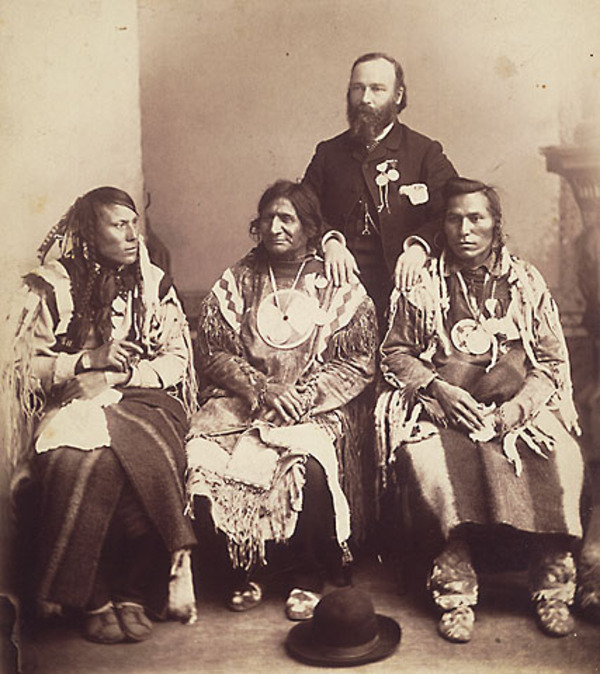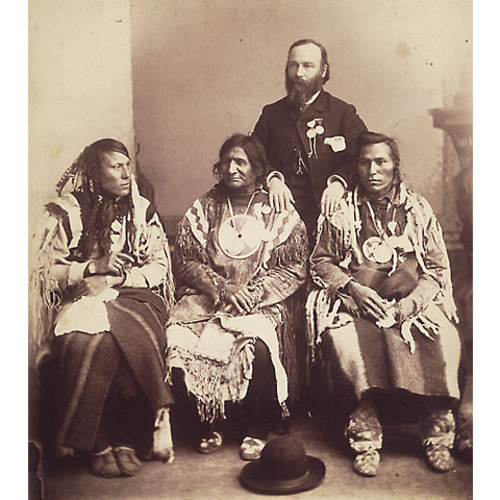NITAI’KIHTSIPIMI (One Spot, or One Spotted Horse), leader of the Six Mouths band of Blood Indians; b. c. 1848 in what is now southern Alberta, son of Ahksatosi (Good Sun); m. Natsikapawayaki (Double Striker), Pitsiksimatapiaki (Snake Body), Emonisaki (Otter Woman), Sikanaskinaiaki (Black Mouse Woman), and Asayikan; d. January 1928 on the Blood Indian Reserve, Alta.
One Spot’s father was a relative of Red Crow [Mékaisto*], leader of the Fish Eaters band, but because he had a large number of followers, he separated in the mid 19th century to form his own band. One Spot became a warrior who was particularly praised for having saved his brother’s life. They were involved in a skirmish with some Assiniboin and were retreating to the protection of a hill when the brother was wounded. One Spot stayed with him, shooting at the enemy and keeping them back until the other Blood had secured fortifications on the hill. Then, under the cover of their fire, he helped his brother to safety. His reputation was such that when his father died, One Spot became chief even though he was still in his twenties. He was probably the youngest person, at age 29, to sign Treaty No.7 in 1877.
Although the Six Mouths band had separated from the Fish Eaters, they maintained friendly relations and often camped together. Because of his youthfulness, One Spot was expected by the government to encourage farming and to keep young men from going to war. In 1885 he worked with Red Crow, who was by then the leading head chief of the tribe, to prevent young Blood from going on horse-raiding expeditions during the North-West rebellion. In 1886 Red Crow selected One Spot to travel with him to Ottawa and Brantford, Ont., during a tour provided to “loyal” chiefs. On their return, Indian agent William B. Pocklington wrote of One Spot, “His visit I am satisfied will be very beneficial as he probably has more influence over the young men than many of the others.”
In 1887 One Spot accompanied his chief to make a peace treaty with the Assiniboin and Gros Ventre Indians. During negotiations at Fort Belknap (Belknap, Mont.), he stated, “Red Crow is our head chief and I come next.” Because of the attention he was receiving from Red Crow and the Indian agent, One Spot expected to be made head chief of the north camp of the Blood in the late 1880s. When that position went instead to Ksistsikoomina (Thunder Chief), he became embittered and joined with dissidents who were trying to challenge Red Crow’s authority. At that time, the Indian agent called him a “Chronic grumbler & jealous of Head Chief.”
As he grew older, One Spot withdrew from tribal politics and devoted his attention to ceremonial life. For example, in 1892, he vowed to make an offering to the Sun Spirit to ensure good health for his children and grandchildren. Former Indian agent Robert Nathanial Wilson witnessed the ceremony in which One Spot was painted from head to foot in red ochre, with black spots applied to his cheeks, nose, and chin, and black lines drawn around his wrists and face. After others in his family also were painted, One Spot produced a scarlet blanket decorated with eagle feathers and sage brush which was fastened to a tree and left as an offering.
One Spot’s ceremonial dress was a combination of modern and traditional. He wore a tall silk hat, white shirt, government-issue military style coat, and beaded leggings and moccasins. In addition, he had “his face gaudily painted, his hair carefully braided, and ears adorned with ear rings.” One Spot lost the use of one eye about the turn of the century, probably because of glaucoma which was prevalent in the tribe, and he became entirely blind a few years later.
As the older chiefs died, One Spot gained prestige because of his role in signing Treaty No.7. As early as 1907 a newspaper described him as a man “who has the distinction of being the only living Indian who signed the treaty of 1877.” Because this pact was considered by the Indians to have been made with Queen Victoria herself, One Spot was selected in 1919 to meet her great-grandson the Prince of Wales during his Canadian tour. Although blind and incapacitated by age, One Spot helped fellow chief Mountain Horse to conduct a ceremony which made the prince an honorary chief. One Spot died in the week prior to 20 Jan. 1928 and was buried on the Blood reserve “with full Indian funeral honors.”
[Details concerning One Spot and the Six Mouths band have been drawn from the author’s interviews with Frank Red Crow in May 1954 and with Jack Low Horn on 21 July 1954. h.a.d.]
GA, M 4421, 285–91. NA, RG 10, 1554: 740–41; 1555: 459; 3875, file 90299. Calgary Herald, 7 Aug. 1907, 20 Jan. 1928. Lethbridge Herald (Lethbridge, Alta), 4 Oct. 1919. H. A. Dempsey, Red Crow, warrior chief (Saskatoon, 1980).
Cite This Article
Hugh A. Dempsey, “NITAI’KIHTSIPIMI (One Spot, One Spotted Horse),” in Dictionary of Canadian Biography, vol. 15, University of Toronto/Université Laval, 2003–, accessed April 17, 2025, https://www.biographi.ca/en/bio/nitai_kihtsipimi_15E.html.
The citation above shows the format for footnotes and endnotes according to the Chicago manual of style (16th edition). Information to be used in other citation formats:
| Permalink: | https://www.biographi.ca/en/bio/nitai_kihtsipimi_15E.html |
| Author of Article: | Hugh A. Dempsey |
| Title of Article: | NITAI’KIHTSIPIMI (One Spot, One Spotted Horse) |
| Publication Name: | Dictionary of Canadian Biography, vol. 15 |
| Publisher: | University of Toronto/Université Laval |
| Year of revision: | 2005 |
| Access Date: | April 17, 2025 |




